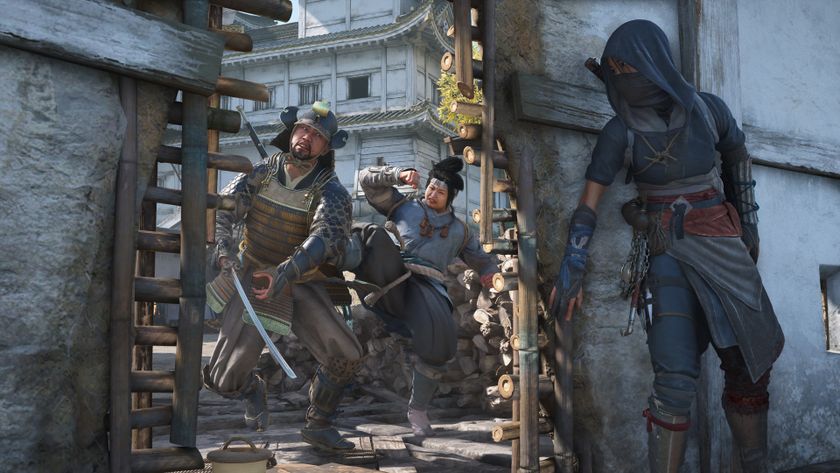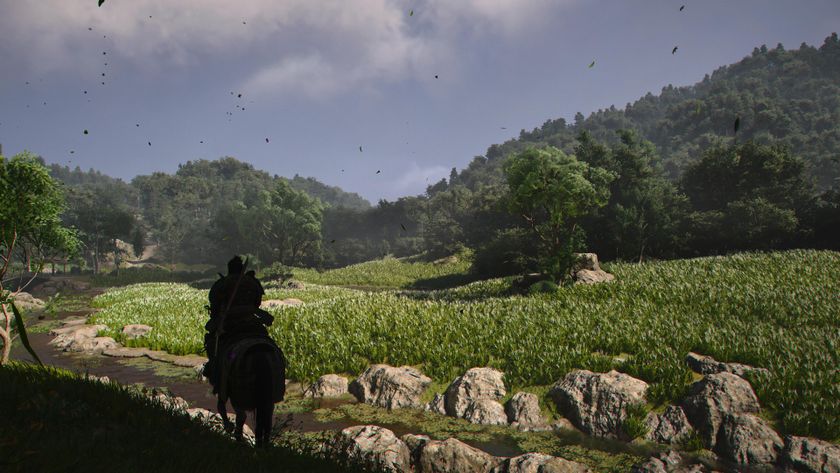The guns of World War II
VIDEO FEATURE: How do the shooters in Medal of Honor: Airborne stack up against the real thing?
The gun: M1911 Colt .45 pistol
The history: The standard sidearm for American troops from 1911 to the mid-'80s, the large-caliber M1911 is still in production and used by civilians and police today. Although the military replaced it with the Beretta M9 in 1985, the Colt saw US troops through numerous wars, and there have been rumblings that it will eventually return as the standard-issue service pistol.
How it feels: Forget all your cherished fantasies of flying sideways down a staircase while brandishing one of these monsters in each hand - the recoil would send your wrists jerking all over the place. Instead, we had to hold this Resident Evil style: right arm stiff and straight, left hand closed over the right fist. The idea is that you use your left hand to pull and aim your right, and then you keep your thumb the hell out of the way of the gun's top-mounted slide, which rockets backward with almost the same force as a bullet and can easily tear your hand apart if you're not careful. With all that in mind, the recoil wasn't nearly as bad as we expected; our wrists jerked up a little with every deafening shot, but overall it was easy to hold the gun steady and pointed in the general direction of the target.
Reality vs game: In real life, a well-aimed .45 slug would be enough to put down all but the biggest, most adrenaline-pumped German soldiers in a heartbeat. In Airborne, however, the Colt is a last-resort weapon that will almost always take several shots to bring down a single, garden-variety Nazi. For what it's worth, though, the in-game gun looks and handles remarkably like its real-life counterpart, even if our soldier fires it with a single steady hand - which, as we've said above, is unwise.
How well is it replicated? The real M1911 is a powerful sidearm; in the game it's a nicely detailed shadow of itself. Standard practice for videogame pistols, but still disappointing after the real thing.
* * *
The gun: Browning Automatic Rifle
Sign up to the GamesRadar+ Newsletter
Weekly digests, tales from the communities you love, and more
The history: A light machine gun that entered military service in 1917, the BAR is a heavy, gas-powered monstrosity with an adjustable rate of fire, an optional pistol grip and a barrel that's prone to overheating. Used mainly during World War II and issued to squads of troops as a heavy fire support gun, it also saw continued use in Korea and Vietnam before being retired by the military in the '60s.
How it feels: Loud, heavy and reeking of gunpowder and hot oil, the BAR was nonetheless one of the smoother experiences we had at the range. Tucked under the shooter's arm like the Thompson or braced against the shoulder for more "precise" aiming, it was mostly recoil-free, although it tended to jerk to the right when fired. We were also cautioned repeatedly not to touch the barrel, as constant firing had made the metal about as hot as your average car cigarette lighter.
Reality vs game: On the range or in the game, the BAR was a sturdy, powerful hunk of machinery that we had a hard time putting down. In Airborne, the gun didn't have the weird need to veer to the right, although it did spray wild bursts and ate through its ammo quickly. Still, it's stronger and more accurate than the Thompson, and was overall our favorite gun
How well is it replicated? Well enough to be accurate, but removed from reality just enough to be fun.
The history: The standard sidearm for American troops from 1911 to the mid-'80s, the large-caliber M1911 is still in production and used by civilians and police today. Although the military replaced it with the Beretta M9 in 1985, the Colt saw US troops through numerous wars, and there have been rumblings that it will eventually return as the standard-issue service pistol.
How it feels: Forget all your cherished fantasies of flying sideways down a staircase while brandishing one of these monsters in each hand - the recoil would send your wrists jerking all over the place. Instead, we had to hold this Resident Evil style: right arm stiff and straight, left hand closed over the right fist. The idea is that you use your left hand to pull and aim your right, and then you keep your thumb the hell out of the way of the gun's top-mounted slide, which rockets backward with almost the same force as a bullet and can easily tear your hand apart if you're not careful. With all that in mind, the recoil wasn't nearly as bad as we expected; our wrists jerked up a little with every deafening shot, but overall it was easy to hold the gun steady and pointed in the general direction of the target.
Reality vs game: In real life, a well-aimed .45 slug would be enough to put down all but the biggest, most adrenaline-pumped German soldiers in a heartbeat. In Airborne, however, the Colt is a last-resort weapon that will almost always take several shots to bring down a single, garden-variety Nazi. For what it's worth, though, the in-game gun looks and handles remarkably like its real-life counterpart, even if our soldier fires it with a single steady hand - which, as we've said above, is unwise.
How well is it replicated? The real M1911 is a powerful sidearm; in the game it's a nicely detailed shadow of itself. Standard practice for videogame pistols, but still disappointing after the real thing.
* * *
The gun: Browning Automatic Rifle
The history: A light machine gun that entered military service in 1917, the BAR is a heavy, gas-powered monstrosity with an adjustable rate of fire, an optional pistol grip and a barrel that's prone to overheating. Used mainly during World War II and issued to squads of troops as a heavy fire support gun, it also saw continued use in Korea and Vietnam before being retired by the military in the '60s.
How it feels: Loud, heavy and reeking of gunpowder and hot oil, the BAR was nonetheless one of the smoother experiences we had at the range. Tucked under the shooter's arm like the Thompson or braced against the shoulder for more "precise" aiming, it was mostly recoil-free, although it tended to jerk to the right when fired. We were also cautioned repeatedly not to touch the barrel, as constant firing had made the metal about as hot as your average car cigarette lighter.
Reality vs game: On the range or in the game, the BAR was a sturdy, powerful hunk of machinery that we had a hard time putting down. In Airborne, the gun didn't have the weird need to veer to the right, although it did spray wild bursts and ate through its ammo quickly. Still, it's stronger and more accurate than the Thompson, and was overall our favorite gun
How well is it replicated? Well enough to be accurate, but removed from reality just enough to be fun.

Assassin's Creed Shadows devs "actively looking at" an even harder difficulty mode for the RPG: "How challenging do you want it?"

Assassin's Creed Shadows' delays were mostly used to polish the RPG, creative director confirms, not for deeper changes brought about by Star Wars Outlaws reaction








